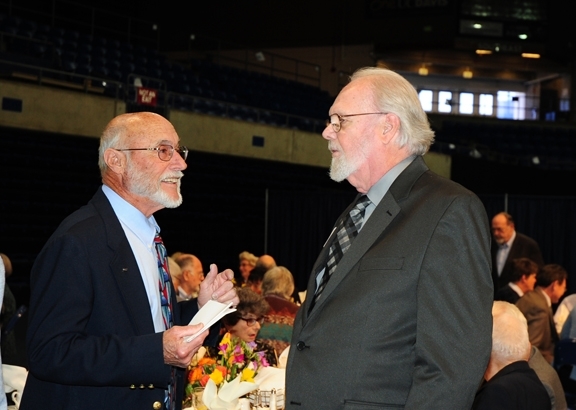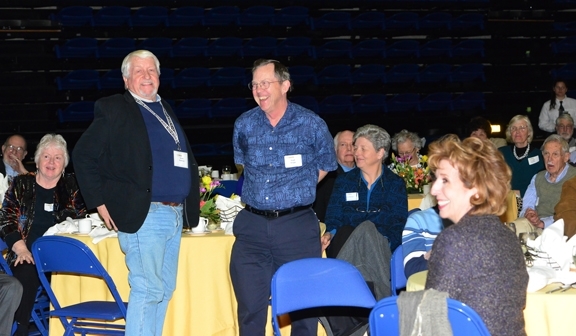
Native pollinator specialist Robbin Thorp, emeritus professor of entomology, received the 2015 Distinguished Emeritus Award and Hugh Dingle, emeritus professor of entomology, received an Edward A. Dickson Emeritus Professor Award at the chancellor's luncheon on Monday, Feb. 23 in the UC Davis Pavilion.
The two emeriti professors from the UC Davis Department of Entomology and Nematology were among those honored at the event. UC Davis Chancellor Linda P. B. Katehi, Provost Executive Vice Chancellor Ralph Hexter, and emcee Bill Rains, past president of the UC Davis Emeriti Association, praised them for their work.
?Robbin Thorp
Thorp was singled out for the distinguished emeritus award for his outstanding scholarly work and service accomplished since his retirement in 1994. "Dr. Robbin Thorp should be the first scientist to be cloned," said emcee Rains, quoting James Cane of the USDA-ARS Pollinating Insect Research Unit, Utah State University, Logan
Thorp, who joined the UC Davis entomology faculty in 1964 and achieved emeritus status in 1994, is a state, national and global authority on pollination ecology, ecology and systematics of honey bees, bumble bees, vernal pool bees, conservation of bees, contribution of native bees to crop pollination, and bees of urban gardens and agricultural landscapes.
Since his retirement, he has compiled an exemplary record for his research, teaching, publications, presentations, and advisement services, sharing his expertise with local, statewide, national and international audiences. In his retirement, he has published 68 papers and is the first author on 15 publications. He received several prestigious awards: the 2013 outstanding team award, with several colleagues, from the Pacific Branch of the Entomological Society of America, and the 2010-2011 Edward A. Dickson Emeriti Professorship, UC Davis. Thorp is the North American regional co-chair for the International Union for Conservation of Nature (IUCN) Bumblebee Specialist group. He is a member of 10 professional societies, including the International Society of Hymenopterists.
A fellow of the California Academy of Sciences since 1986 and a world authority on bumble bees and other native bees, Thorp keynoted the Smithsonian Institution's public symposium on “The Plight of the Bumble Bees” in June of 2009 in Washington D.C., delivering a presentation on “Western Bumble Bees in Peril.” He continues to monitor bumble bee populations in California and Oregon, including Franklin bumble bee (Bombus franklini), which he fears may be extinct. He has sounded the alarm on protecting bumble bees.

Thorp spends much of his time in the Bohart Museum of Entomology, which houses collections critical to his bee identification work. He identifies species and regularly volunteers at the open houses and other event.
Thorp is an integral part of The Bee Course, an annual 10-day workshop sponsored by the American Museum of Natural History and held at the Southwestern Field Station near Portal, Ariz. He has taught there since 2002 (the instructors are all volunteers), and even though he is 81 years young, he plans to continue teaching there. (See more on the departmental web page.)
Hugh Dingle?
Hugh Dingle. an international authority on animal migration, received a Dickson award to help fund his research on monarch butterflies, “Monarchs in the Pacific: Is Contemporary Evolution Occurring on Isolated Islands?” Monarch butterflies established just 200 years ago in remote Pacific islands are undergoing contemporary evolution through differences in their wing span and other changes, he believes.
Dingle, author of two editions of Migration: The Biology of Life on the Move, said his previous studies reveal that migrant and resident monarchs exhibit different wing shapes. He will be working with community ecologist/associate professor Louie Yang and molecular geneticist/assistant professor Joanna Chiu of the UC Davis Department of Entomology and Nematology to examine the ecology and physiology of monarch butterflies (Danaus plexippus) in three islands where contemporary evolution might be expected. The islands are Oahu (Hawaii), Guam (Marianas) and Weno (Chuuk or Truk).
“This is the necessary first step in a long-term analysis of the evolutionary ecology and physiology of monarch butterflies on remote Pacific islands,” said Dingle, a fellow of the American Association for the Advancement of Science and the Animal Behavior Society.
Dingle said the monarch, widely distributed “for eons” in the New World, is fairly new to the Pacific islands and to Australia. “In addition to North America, the monarch occurs as a resident throughout the Caribbean and Central and northern South America—and probably as a migrant farther south. One of the more intriguing aspects of its distribution is that beginning in the early part of the 19th century, it spread throughout the Pacific all the way to Australia, where there are now well-established."
An analysis of a monarch population in Hawaii shows that resident monarchs have shorter, broader wings than the long-distance migrants. The Hawaii butterfly wings were shorter than the eastern U.S. long-distance migrants, but “not so short-winged as the residents in the Caribbean or Costa Rica, which have been present in those locations for eons, rather than the 200 years for Hawaii.”
“If there are indeed wing shape changes associated with evolution in isolation, are there other changes that may have occurred under selection and local adaptation for residency?” Dingle wonders. “Are there other changes that may have occurred under selection and local adaptation for residency? Examples of such traits might be changes in flight muscle physiology, changes in photoperiodic diapause response, changes in the characteristics of orientation ability and its relation to antennal circadian rhythms, or changes in the reproductive capacity or tactics (re-colonization of ‘empty' habitats is no longer part of the life cycle).
Dingle published the second edition of Migration: The Biology of Life on the Move (Oxford University Press) in November 2014. It is the sequel to the widely acclaimed first edition, published in 1996. National Geographic featured Dingle in its cover story on “Great Migrations” in November 2010. LiveScience interviewed him for its November 2010 piece on “Why Do Animals Migrate?” (See more on the departmental web page.)
Congratulations, Distinguished Professor Emeritus Robbin Thorp, and Dickson Professorship Awardee Hugh Dingle!
(Note: This blog, Bug Squad, focuses on entomology. Other recipients of the Dickson award were Daniel Anderson of the Department of Land, Air and Water Resources; Martha Macri of the Department of Linguistics; and Peter Schiffman, Department of Geology. (See web page.)
Attached Images:

Emcee Bill Rains (left) congratulations Robbin Thorp. (Photo by Kathy Keatley Garvey)

From left are Provost and Executive Vice Chancellor Ralph Hexter; emcee Bill Rains; Robbin Thorp, distinguished emeritus professor; and Chancellor Linda P. B. Katehi. (Photo by Kathy Keatley Garvey)

Hugh Dingle (standing right) and Daniel Anderson (standing left), two of the Dickson recipients, receive the applause of the crowd. (Photo by Kathy Keatley Garvey)